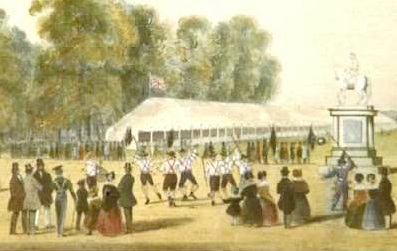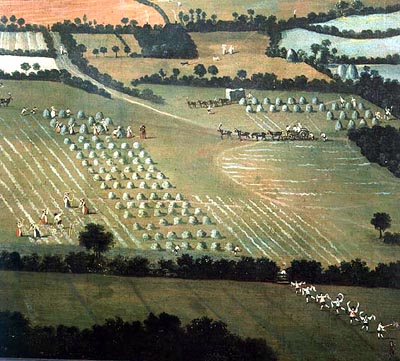MARVELS AND MORRIS DANCING
Back to Introduction and Contents

Morris dancing at Stowe House, Buckinghamshire 1844
Well it had to come, the collision
of two major interests: morris dancing meet Enstone Marvels. Here is an
extract from Jackson's Oxford Journal for May 19th. 1791. printed without comment on the back cover of The Story of Enstone by Graham Binns.
| "A cake and ale feast
will be held at Enstone, Oxfordshire, on Monday, Tuesday,Wednesday and
Saturday in Whitsun week next ensuing. A CROWN CAKE will be given to
the Set of Maurice Dancers that appears at Enstone first on Whit
Monday. A HALFCROWN CAKE will be given to the first set of Maurice
Dancers on Tuesday and a GOLD LACED HAT will be danced for by the
Maurices on Saturday. Enstone Wells being in high condition, and a large commodious Room over them, there will be a ball on each of the above nights." |
For those not familiar with the habits of morris dancers this account clearly refers to the common custom of hosting
Whitsun Ales in many Midland parishes. Originally brought in as
fund-raising activities for churches after the reformation by the
eighteenth century they had become social gatherings and from the point
of view of the morris dancers offered lucrative money making
opportunities (Chandler 1993a: 57). It was common practice for groups of dancers to travel some distance
to participate in such events although there was usually a host side
that would represent the village. What is interesting is that Enstone,
despite being in the heartland of Cotswold morris dancing, does not seem
to have had its own set of dancers and is forced, at least in 1791, to
advertise to attract this essential component of the festivity The
notion of dancing competitively was also found frequently, for example
Chandler quotes another account from Jacksons Oxford Journal, this time
from May 21st 1808 pertaining to Brill in Buckinghamshire:
"HIS LORDSHIP... will give a PRIZE of RIBBANDS and a HAT of one Guinea value, to the best set of Oxfordshire morris"
Whit Monday is clearly more
important than the Tuesday in terms of the need to attract quality
performers although if that hat was anything like the Brill example
Saturday was when the big money could be made. The crown and halfcrown
cakes referred to were usually large plum cakes, not dissimilar to
those carried around by Bampton Morris to this day. It seems that the
prizes were generally sold and the proceedings divided up amongst the
dancers and musician.

The Dixton Harvesters, Gloucestershire morris in the late eighteenth century.
One wonders which local teams would have been attracted by the advertisement to turn up for the event. Chandler in his gazetteer of morris dancing in the South Midlands between 1660 - 1900 attempts to identify villages with active groups of morris dancers. The chief candidates for the late eighteenth century would have been Ascot-Under-Wychwood, Milton-Under-Wychwood, Spelsbury (which unusually had a women's team), Adderbury, Burford, Finstock and Woodstock although the records are fragmentary at best and there must have been others.
The fact that the Wells are in 'high condition' indicates that the Marvels remained in a reasonable state of repair right up to the end of the eighteenth century but by 1805 the poet Robert Southey who was passing through recorded,
Perhaps the Whitsun ale with its accompanying advert was part of a last ditch attempt to maintain the Wells as a going concern.

The Dixton Harvesters, Gloucestershire morris in the late eighteenth century.
One wonders which local teams would have been attracted by the advertisement to turn up for the event. Chandler in his gazetteer of morris dancing in the South Midlands between 1660 - 1900 attempts to identify villages with active groups of morris dancers. The chief candidates for the late eighteenth century would have been Ascot-Under-Wychwood, Milton-Under-Wychwood, Spelsbury (which unusually had a women's team), Adderbury, Burford, Finstock and Woodstock although the records are fragmentary at best and there must have been others.
The fact that the Wells are in 'high condition' indicates that the Marvels remained in a reasonable state of repair right up to the end of the eighteenth century but by 1805 the poet Robert Southey who was passing through recorded,
"... we were
told there were some water-works which would amuse us if we were in
time to see them... It was but a melancholy site. The gardens made in
the times of Charles I, above a century and half ago, and everything
about them was in a state of decay. the water-works are of that kind
which were fashionable in the days when they were made; ingenious
devices for wetting the beholder from the sides, roof, floor and
door-way of the grotto into which he had entered, and from every object
which excited his curiosity.' (Southey 1808: Letter 34)
Perhaps the Whitsun ale with its accompanying advert was part of a last ditch attempt to maintain the Wells as a going concern.